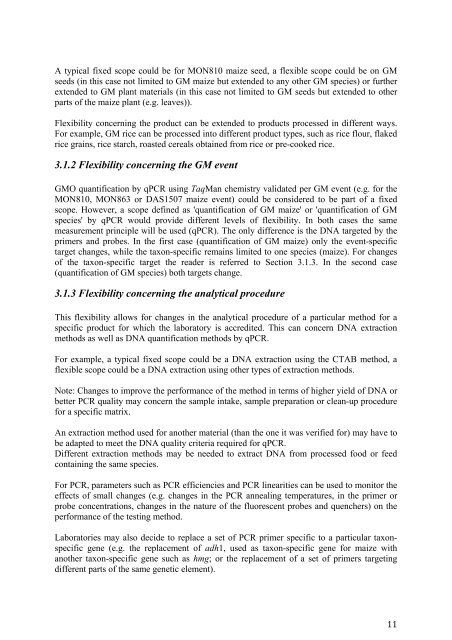final%20report%20online%20upd
final%20report%20online%20upd
final%20report%20online%20upd
Create successful ePaper yourself
Turn your PDF publications into a flip-book with our unique Google optimized e-Paper software.
A typical fixed scope could be for MON810 maize seed, a flexible scope could be on GM<br />
seeds (in this case not limited to GM maize but extended to any other GM species) or further<br />
extended to GM plant materials (in this case not limited to GM seeds but extended to other<br />
parts of the maize plant (e.g. leaves)).<br />
Flexibility concerning the product can be extended to products processed in different ways.<br />
For example, GM rice can be processed into different product types, such as rice flour, flaked<br />
rice grains, rice starch, roasted cereals obtained from rice or pre-cooked rice.<br />
3.1.2 Flexibility concerning the GM event<br />
GMO quantification by qPCR using TaqMan chemistry validated per GM event (e.g. for the<br />
MON810, MON863 or DAS1507 maize event) could be considered to be part of a fixed<br />
scope. However, a scope defined as 'quantification of GM maize' or 'quantification of GM<br />
species' by qPCR would provide different levels of flexibility. In both cases the same<br />
measurement principle will be used (qPCR). The only difference is the DNA targeted by the<br />
primers and probes. In the first case (quantification of GM maize) only the event-specific<br />
target changes, while the taxon-specific remains limited to one species (maize). For changes<br />
of the taxon-specific target the reader is referred to Section 3.1.3. In the second case<br />
(quantification of GM species) both targets change.<br />
3.1.3 Flexibility concerning the analytical procedure<br />
This flexibility allows for changes in the analytical procedure of a particular method for a<br />
specific product for which the laboratory is accredited. This can concern DNA extraction<br />
methods as well as DNA quantification methods by qPCR.<br />
For example, a typical fixed scope could be a DNA extraction using the CTAB method, a<br />
flexible scope could be a DNA extraction using other types of extraction methods.<br />
Note: Changes to improve the performance of the method in terms of higher yield of DNA or<br />
better PCR quality may concern the sample intake, sample preparation or clean-up procedure<br />
for a specific matrix.<br />
An extraction method used for another material (than the one it was verified for) may have to<br />
be adapted to meet the DNA quality criteria required for qPCR.<br />
Different extraction methods may be needed to extract DNA from processed food or feed<br />
containing the same species.<br />
For PCR, parameters such as PCR efficiencies and PCR linearities can be used to monitor the<br />
effects of small changes (e.g. changes in the PCR annealing temperatures, in the primer or<br />
probe concentrations, changes in the nature of the fluorescent probes and quenchers) on the<br />
performance of the testing method.<br />
Laboratories may also decide to replace a set of PCR primer specific to a particular taxonspecific<br />
gene (e.g. the replacement of adh1, used as taxon-specific gene for maize with<br />
another taxon-specific gene such as hmg; or the replacement of a set of primers targeting<br />
different parts of the same genetic element).<br />
11
















